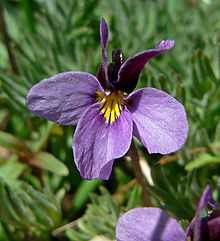Viola beckwithii
From Wikipedia, the free encyclopedia
| Viola beckwithii | |
|---|---|
 | |
| Conservation status | |
| Scientific classification | |
| Kingdom: | Plantae |
| (unranked): | Angiosperms |
| (unranked): | Eudicots |
| (unranked): | Rosids |
| Order: | Malpighiales |
| Family: | Violaceae |
| Genus: | Viola |
| Species: | V. beckwithii |
| Binomial name | |
| Viola beckwithii Torr. & A.Gray | |
Viola beckwithii, known commonly as the Great Basin violet, Beckwith's violet, and sagebrush pansy, is a species of violet native to the western United States.[1] It is an early-flowering plant of sagebrush (Artemisia tridentata) habitats in the Great Basin region.
This is a perennial herb with several decumbent or erect stems growing from a caudex. The stems are up to about 22 centimeters long, often with much of their length underground. The fleshy compound leaves have dissected leaflets of varying shape and size. Flowers arise from the leaf axils. The upper two petals are reddish violet, and the lower three are purplish to white with purple veining and yellow or orange bases.[2]
See also
References
| Wikimedia Commons has media related to Viola beckwithii. |
| Wikispecies has information related to: Viola beckwithii |
- ↑ USDA PLANTS: Viola beckwithii. Accessed 8 January 2013.
- ↑ Viola beckwithii. The Jepson eFlora 2013.
External links
- Viola beckwithii. Germplasm Resources Information Network (GRIN).
- Viola beckwithii. Calflora 2013.
- Viola beckwithii. CalPhotos.
This article is issued from Wikipedia. The text is available under the Creative Commons Attribution/Share Alike; additional terms may apply for the media files.
